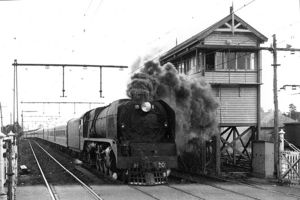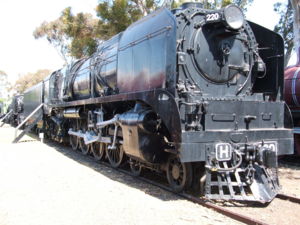Victorian Railways H class
| Victorian Railways H class Victorian Railways builder's photograph of H 220, 1941 | |
| Power type | steam |
|---|---|
| Builder | VR Newport Workshops |
| Configuration | 4-8-4 |
| Driver size | 67 in (1702 mm) |
| Length | 92 ft 5¾ in (28.19 m) |
| Axle load | 23 t 5 cwt (23.6 t) |
| Weight on drivers | 92 t 12 cwt (94.1 t) |
| Total weight | 146 t 10 cwt (148.9 t) (engine) 113 t 11 cwt (117.4 t) (tender) 260 t 1 cwt (264.2 t) (total) |
| Tender capacity | 9 t coal, 14,000 gal (63,600 L) water |
| Boiler pressure | 220 psi (1.52 MPa) |
| Fire grate area | 68 ft² (6.3 m²) |
| Heating surface: Total | 4,760 ft² (442 m²) |
| Cylinders | 3 |
| Cylinder size | 21½×28 in (546×711 mm) |
| Tractive effort | 55,000 lbf (245 kN) at 85% boiler pressure |
| Number in class | 1 |
The H class was an express passenger steam locomotive that ran on Victorian Railways from 1941 to 1958. Intended to eliminate the use of double heading A2 class locomotives on Overland services on the steeply graded Western line to Adelaide, wartime restrictions led to only one locomotive being built. Nicknamed "Heavy Harry", H 220 was the largest non-articulated steam locomotive ever built in Australia.
Contents
History
By the late 1930s, the aging A2 class 4-6-0 locomotives, first introduced in 1907, were hauling passenger trains far heavier than those for which their designers had intended them. The S class 4-6-2 'Pacifics' had displaced them from North-eastern line services from 1928 onwards and allowed a faster timetable to be introduced; however, a Pacific-type locomotive was not necessarily ideally suited for the Western line. The section between Melbourne and Ballarat had sharply curved, steep inclines, the most notorious of which was the 10-mile, 1 in 48 gradient of the Ingliston bank.[1] The VR opted to design a new locomotive for the task.
Design brief
In 1936, the major design requirements were finalised by the Victorian Railways Design Office for a steam locomotive that was capable of hauling a load of 550 tons (560 t) at 20 mph (32 km/h) up Ingliston Bank.[1] In order to develop the horsepower required, a very large grate was required, as well as a very large boiler. A 4-8-4 locomotive, with a four-wheel trailing truck to support a large firebox and four coupled axles to support a large boiler and ensure a good factor of adhesion, would have seemed the logical choice.
VR designers wished to improve on aspects of the earlier S class design. These three-cylinder Pacifics, although capable of hauling heavy loads at high speed, had in practice proved to be relatively maintenance-intensive, particularly with regard to the servicing of the valve gear and motion for their third (inside cylinder).

|

|
| Detail of the connecting rod for the third cylinder (left), and valve gear stem and crosshead guide, located between the outside cylinders. (right) | |
To this end, the H class had a significantly different arrangement for its third cylinder. A German-style conjugated valve gear mechanism was utilised in favour of the Gresley conjugated valve gear that had featured on the S class.[2] The inside cylinder was also positioned further forward of the outside cylinders and drove the leading coupled axle, with the outside cylinders driving the second coupled axle.[3]
The H class also became the first VR locomotive to feature a mechanical stoker, and boasted many other modern features such as roller bearings, power-operated reversing gear, American-style bar frame construction, thermic siphons, and duplex blast pipes.[3]
Production
Construction of three H class locomotives at VR's Newport Workshops commenced in 1939, but was halted due to the outbreak of war. Due to a shortage of motive power caused by increased wartime traffic, classleader H 220 was completed and went into service on 7 February 1941.
The two additional H class locomotives planned (H 221 and H 222) remained incomplete as wartime production of armaments (and later postwar rebuilding of badly run-down infrastructure) took precedence over express passenger locomotive construction. They were never completed, and it is believed that whatever parts had been assembled were scrapped some years later.
Service life

Although it had been built to work the Western line to Ararat, a number of bridges along the route required strengthening before the H class locomotive with its 23¼ ton axle load could enter regular service on this line. This work was deferred due to wartime restrictions on available resources. As such, H 220 was put to work on the only line able to accommodate its loading gauge and high axle load: the North-Eastern line to Albury, where it hauled express passenger services, fast goods services, troop trains, and on the odd occasion when the regular S class Pacific was not available, the Spirit of Progress.
H 220 never operated in its intended role as power for The Overland, although it did make a brief appearance on the Western line in 1949 when it ran a series of trials with the VR dynamometer car on goods trains from Melbourne to Ballarat. Results from the dynamometer car showed that the locomotive developed around 3,300 drawbar horsepower (2,460 kW) at 47.5 mph (76 km/h), and a starting drawbar tractive effort of 52,000 lbf (230 kN).[4]
From all accounts, H 220 was a success even though it spent its life hauling services and operating on a line it was not specifically designed for. Although one-off locomotives are often consigned to a short operating life or underutilised due to non-standardisation of parts and maintenance requirements, H 220 remained in service until finally being superseded by diesel electric locomotives in the late 1950s. In a service life of 15 years 3 months, it clocked up a total of 821,860 miles (1,322,660 km),[3] averaging over 4,800 miles per month.
Demise
Even after the war, upgrades on the line to Ararat necessary for H class operation were not made as the VR struggled with a backlog of maintenance work during the 1940s. When the VR finally embarked on major capital investment in the early 1950s, diesel and electric traction were now under consideration. Although diesel locomotives of the early 1950s typically had far lower horsepower outputs than the H class, they could be run in multiple-unit operation with one crew controlling two or more locomotives. In 1952, two B class diesel electric locomotives established their credentials during trials hauling a 1,300 ton load up Ingliston bank[5], effectively providing the same (if not better) performance as the H class but without the heavy axle load and requirements for upgraded infrastructure. They became the new motive power not only for The Overland, but also mainline goods service as well. The days of mainline steam locomotives were now numbered.
H 220 continued in service until it was withdrawn for an overhaul on 20 May 1956. By this time, the C and X class heavy goods locomotives were now being withdrawn from service and scrapped as B class diesel electrics and L class electric locomotives made them redundant. H 220 was stored rather than overhauled, and never returned to service. It was written off the VR locomotive register on 30 April 1958.
Preservation

H 220 survived more-or-less intact until 1960, when the Australian Railway Historical Society successfully lobbied for the establishment of a railway museum. H 220 entered the museum at North Williamstown in 1962, and since this date has appeared as its star exhibit. Although VR built two further classes of steam locomotive after the H (the 1951 R class 4-6-4 and 1954 J class 2-8-0), the H class is regarded as the ultimate example of VR's former design and manufacturing capability.
It is believed that H 220 is now the world's only remaining example of a three-cylinder 4-8-4.[6]
References
- Dee et al, Power Parade, VicRail Public Relations Division, Melbourne, 1981, ISBN 978-0-7241-3323-9
- Pearce et al, North Williamstown Railway Museum, ARHS, Melbourne, 1980, ISBN 978-0-85849-018-5
Specific
- ↑ 1.0 1.1 ARHS Railway Museum: What to see - H220. Retrieved on 2006-10-15.
- ↑ Public Records Office Victoria - VPRS 12800/P1 H 4584C. Retrieved on 2006-11-06.
- ↑ 3.0 3.1 3.2 Pearce et al, p. 19
- ↑ Public Record Office Victoria - VPRS 12903/P1 Box 626/08 Dynamometer Car Tests Locomotive H220. Retrieved on 2006-11-08.
- ↑ Public Record Office Victoria VPRS 12800/P1 H 2545. Retrieved on 2006-11-08.
- ↑ (based on SNCF 242A1 and DR BR 06 4-8-4 locomotives being scrapped) VICTORIAN RAILWAYS H CLASS 4-8-4. Retrieved on 2006-11-06.
External links
- victorianrailways.net Glenroy Bank - comparison photographs of H 220 (in 1941) and a modern V/Line diesel electric locomotive (in 2004) both hauling passenger services past the same vantage point, 63 years apart.
- victorianrailways.net Seymour - H 220 on a livestock train, circa 1950. The valance below the cab appears to have been removed by this time.
- steamlocomotive.com Locobase #7687
- Museum of Victoria - Victorian Railways - H Class Loco 'Heavy Harry'
- Wandong Live Steam - Photograph of a 5" gauge live steam model of H 220, adjacent to a New York Central Railroad 4-8-2 'Mohawk'. An interesting comparison of the relative loading gauge constraints of the VR and NYCRR, most notably the 14' height constraint of the VR.
